We treat and prevent tomato diseases: how to process tomatoes with Bordeaux mixture - step-by-step instructions for beginners
Tomatoes, like many other cultivated and wild plants, are susceptible to disease. Most often, vegetables get sick with fungal infections. Late blight, powdery mildew, Alternaria infect the culture, gradually killing it. To combat fungi, experienced gardeners advise using Bordeaux mixture. What it is and how to use the liquid correctly, we will consider further.
The content of the article
What is this mixture
Bordeaux liquid is an aqueous solution of calcium hydroxide and calcium sulfate. In simple terms, the mixture consists of water, quicklime and copper sulfate. The fight against fungus occurs at the cellular level.
When the solution is used
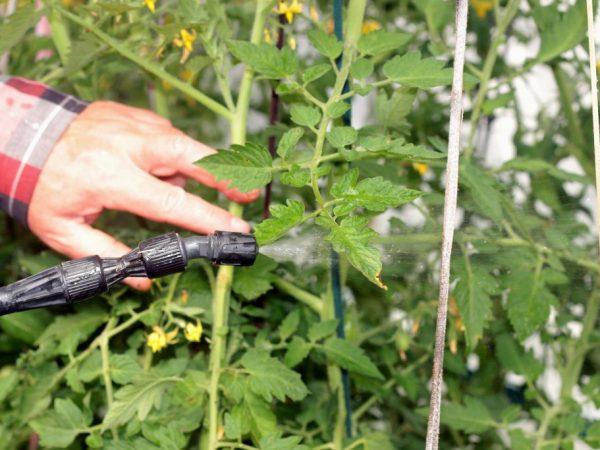
The liquid is used mainly as a prophylaxis for viral and fungal diseases. It is important to observe the proportions and recommendations for use. The drug copes especially well with the following diseases:
- Phytophthora... The fungus is capable of infecting a huge number of tomato bushes in a short time. It appears as brown spots and white bloom. The pest quickly destroys a large number of bushes and infects adjacent beds. To combat late blight, treatment with Bordeaux mixture begins immediately.
- Brown spot most often applies to tomatoes that grow in a greenhouse. Brown spots appear on the bottom of the plant, and light ones on the top. Before processing tomatoes in the greenhouse, it is important to remove and burn all affected plant parts.
- Streak... The disease eats up the leaves and the root system of the tomato in a short time. Because of it, the fruits lose their taste, and the stems die.
Important! In addition to the preventive and therapeutic effect, the drug improves the quality of tomatoes in the future, improves their shelf life.
Advantages and disadvantages of the tool
Like many other drugs, Bordeaux liquid has its own strengths and weaknesses.
Benefits of the drug:
- has a noticeable effect against many pathogens and microbes;
- protects plants for a month;
- is not washed off by rain and watering;
- quickly comes into contact with the plant;
- supplies tomatoes with calcium.
Disadvantages of the drug:
- with an overabundance of it, tomatoes crack and leaves fall;
- may be toxic to other plants;
- accumulates over the years in the ground, which has a bad effect in the future on berry bushes and trees;
- together with groundwater, copper can enter water bodies;
- adherence to jewelry accuracy in dosages is required, since copper is a poison for humans;
- if it enters the human body, strong side effects;
- cannot be used during flowering;
- possible side effects in the form of burns on the leaves.
How to cook properly
In cooking, it is important to observe the exact proportions and rules. In no case should you prepare Bordeaux liquid "by eye".
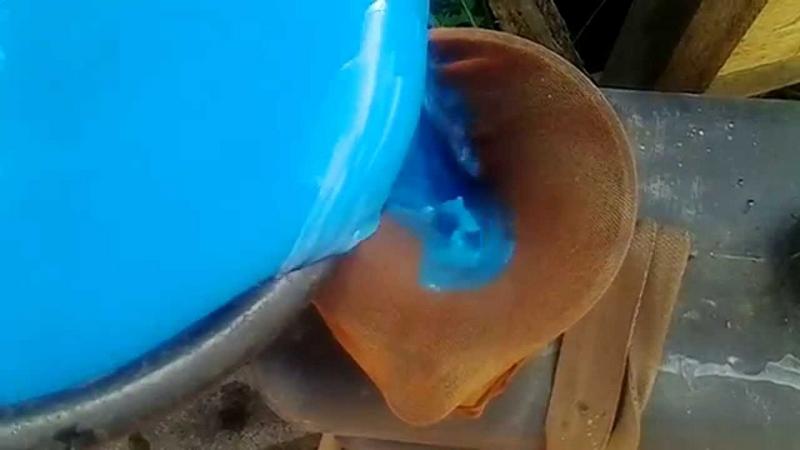
Components and rules
For cooking, you need copper sulfate, quicklime and water. Purchase them from specialty garden shops. The shelf life of copper sulfate should be no more than two years, and with lime it is necessary to work in a room with a minimum humidity level.
In addition to the main ingredients, you will need a sieve, cheesecloth, large and small pots, scales, a wooden stick and a nail. It is best to take plastic or glass containers. Make sure they are chip-free.
The cooking process looks like this:
- pour hot water into a five-liter saucepan;
- pour vitriol;
- top up with cold water and stir with a wooden stick;
- pour 2 liters of water into a ten-liter saucepan;
- pour lime and stir;
- add cold water so that the pan is half full;
- pour a solution of copper sulfate;
- fold the cheesecloth and strain.
Important! Do not mix components dry or use components at different temperatures. The solutions in the pans must be cold.
After cooking, experienced gardeners are advised to check the chemical reaction. To do this, a nail is dipped into the solution. If the solution is not prepared correctly, then a red coating will remain on the nail. The liquid can burn the plant because it contains an increased dose of copper sulfate. To correct the situation, add milk of lime to the solution until the nail is no longer covered with copper.
Proportions
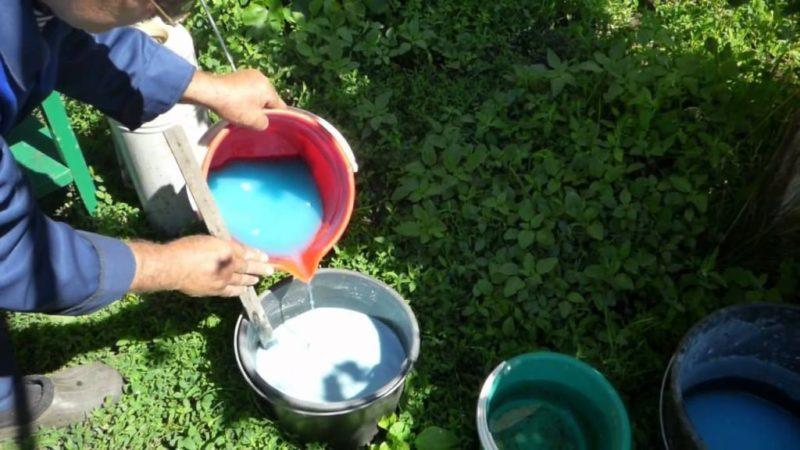
Be sure to respect the proportions. The concentration of the spray mixture is 1% or 0.75%.
For a 1% solution you will need:
- 10 liters of water;
- 150 g quicklime;
- 100 g of copper sulfate.
The composition of the mixture is 0.75%:
- 10 liters of water;
- 100 g quicklime;
- 0.075 kg of copper sulfate.
Important! And in a greenhouse, and in open ground for 10 square meters. m you need 2 liters of the mixture.
Using ready-made Bordeaux liquid in bottles
A ready-made solution of Bordeaux liquid has gained popularity among gardeners.Mix the water and liquid in the correct proportions according to the directions on the bottle. For example, to get 1% liquid, combine 100 ml of water and 100 ml of Bordeaux.
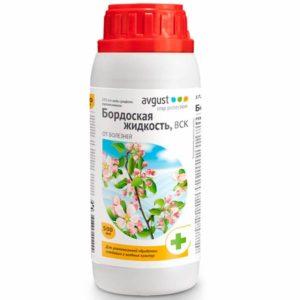
Such a solution also has a preventive and therapeutic effect on tomatoes. It is easy to use, you do not need to spend time and effort preparing the drug yourself.
The plant is sprayed in spring or autumn. The operations are performed carefully, strictly according to the recommendations indicated on the bottle. The slightest inaccuracies can damage the tomatoes and cause burns on the bushes.
How to properly process tomatoes with this liquid
How to process tomatoes with Bordeaux mixture? The procedure does not tolerate errors, therefore it is recommended to study the rules before using the mixture.
Step-by-step instruction
When the liquid is ready, and the consumption of the drug is calculated, start processing the tomatoes:
- Choose the right time. A day when there is no dew, rain or wind is best.
- Prepare rubber gloves, goggles, and a respirator. A sprayer with a small tip is considered the most convenient.
- Begin the procedure. Treat only those parts of the bushes that show signs of the disease.
Read also:
The best varieties of greenhouse tomatoes that are resistant to late blight.
A guest in the garden named after the star: the Canopus tomato.
Treatment frequency and precautions
The frequency of processing is no more than four times per season. It is better to carry out the procedure three times with an interval of 10 days. You cannot spray the bush when it is blooming or forming fruit, or if there are other vegetables nearby that you plan to harvest in 2 weeks. If the disease affects the seedlings, process them 14 days before planting.
Important! Bordeaux liquid can not only help, but also harm. It is strictly forbidden to eat, drink and smoke during the procedure. After processing, you must thoroughly rinse your face, hands and tools. Also, during the procedure, children and animals are not allowed to be near you.
Features of use in the greenhouse and in the open field
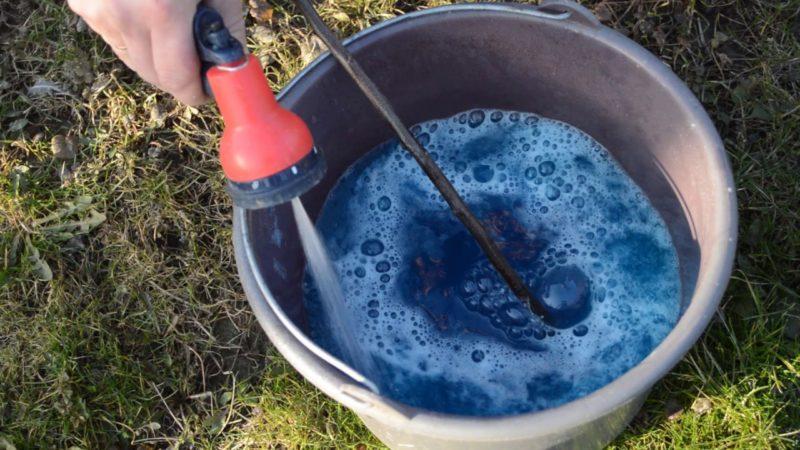
When processing in a greenhouse, it is recommended to moisten the bush abundantly and evenly so that the liquid flows down the stem and leaves. So it will penetrate into all cracks, and it is there that dangerous pathogens are contained.After that, open all the doors and vents in the greenhouse - the structure should be ventilated.
In the open field, it is advised to process the plant in early summer. A 1% solution is especially suitable for this. Thus, you protect the bushes from hazards at the very beginning of the growing season, that is, during the ripening period.
Popular questions
On thematic forums, gardeners often discuss the use of Bordeaux mixture. This is what gardeners are especially interested in.
Which is better: Bordeaux mixture or copper sulfate?
Copper sulfate is a mixture of warm water and vitriol. It is used not only for the prevention of bushes, but also for the treatment of wooden structures. Most gardeners are sure that Bordeaux liquid is still better than copper sulfate.
The fact is that it is safer for plants and humans. Also, the likelihood that copper sulfate will burn the leaves is much higher.
How soon after processing can tomatoes be eaten?
Tomatoes can be used after processing at least 2 weeks after the last operation. The same rule applies to nearby vegetables and fruits. As expected, mature vegetables must be washed well before use.
Tips & Tricks
If you do not want to prepare the liquid yourself, purchase a dry mixture at a specialty store and simply dilute it with water. In a concentrate format, the mixture is more convenient, but it also costs an order of magnitude more.
If Bordeaux liquid enters the body, coughing, sneezing, weakness, chills may occur. In this case, immediately call an ambulance, do not hope that the side effects will go away by themselves.
If the drug gets into the respiratory tract, take a diuretic or antipyretic drug. In case of contact with skin, rinse thoroughly with plenty of water. And if the liquid has entered the gastrointestinal tract, but gastric lavage and activated charcoal are required.
Important! In addition to tomatoes, flower, berry, fruit shrubs and trees are treated with liquid.
Conclusion
You only need to prepare the mixture according to the recipe. Bordeaux liquid is used in greenhouses and in the open air. Since the mixture is toxic, be sure to prepare rubber gloves, a respirator and goggles before handling it.
If the solution enters the body, immediately call an ambulance or take the above medications.